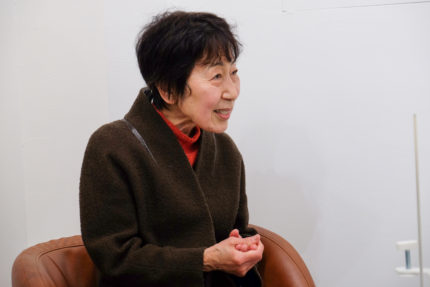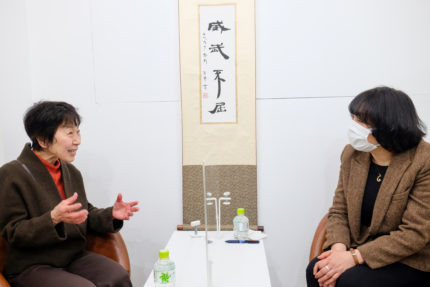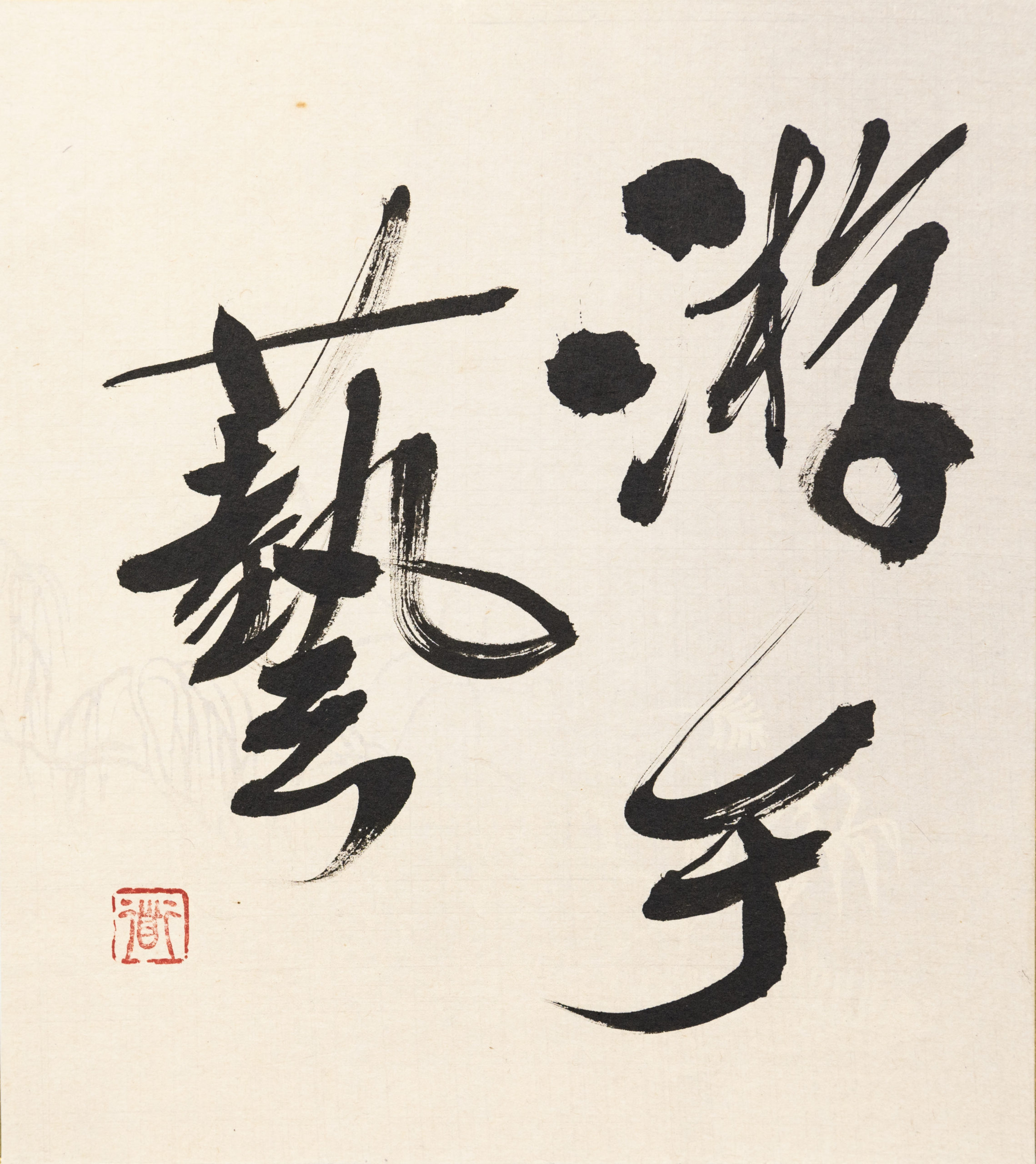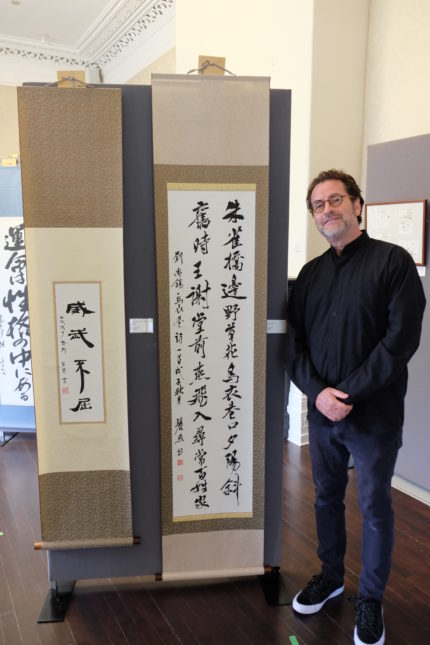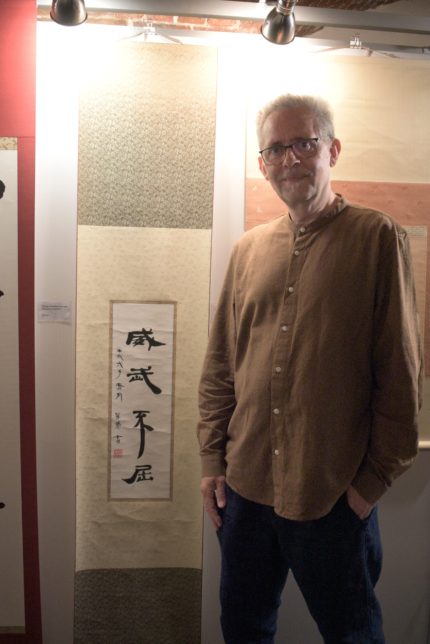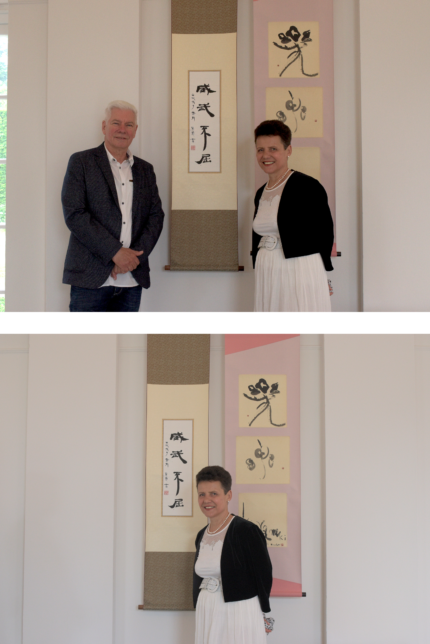- JEPAA Member
- Calligraphy
- Reiku Idoguchi
- 書道家
- 井戸口麗煦
© 2024 Reiku Idoguchi.
SCROLL
Portfolio /作品一覧
- 威武不屈/Ibu-Hukutsu Unyielding
- 客中行/Song while traveling
- 烏衣巷劉禹錫/Wu Li Lane
対談 /conversation
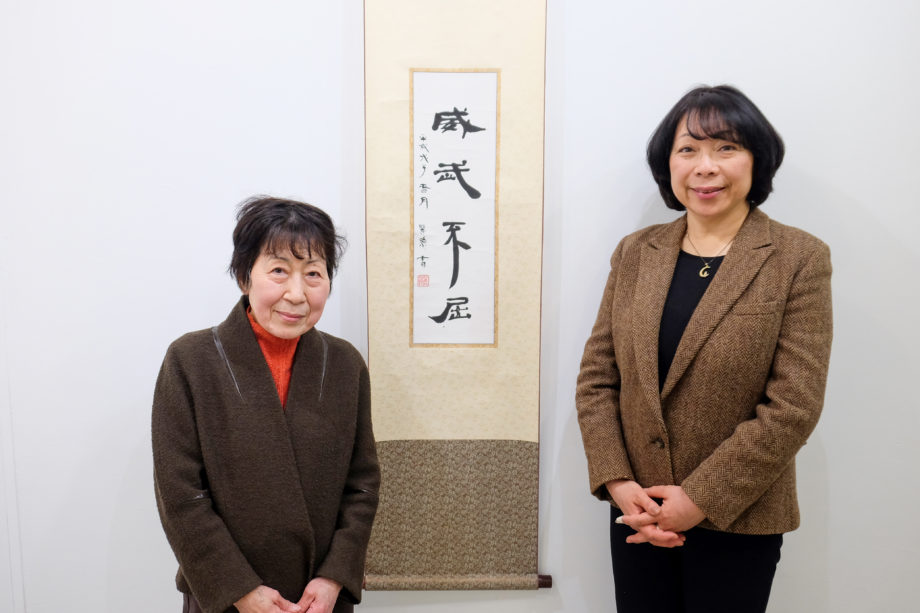
世界へ、そして次の世代へ。書道文化を伝える慈愛の伝道師
ゲルマー・トモコ(以下 ゲルマー):井戸口先生の作品は、池袋やドイツの展覧会で拝見していました。ご本人にお会いできて光栄です。
井戸口(以下 井戸口):私も、以前は毎年のようにウルム(ドイツの都市)に住んでいる友人を訪ねていたので、ドイツやゲルマーさんには大きなご縁を感じています。
ゲルマー:本当ですか!ウルムはとても良い街ですよね。私も先生とは特別なご縁があると思っていて、素晴らしい書だと注目していました。まずはその作品についてお話を伺えますか?
井戸口:私は初め漢字仮名交じりの得意な先生について学んでいましたので、展覧会の出品作品はすべて詩文でした。近代詩文書から学び始めて、その後「中国書法学院」に入学して、甲骨文字から始まり 21 書体を教わりました。その先生が自分の四字熟語の書を集めた作品集を出されていて、そこから創作の着想を頂いたのが「威武不屈」です。私も元々は漢字かな混じりの作品が中心ですが、最近書いているのはほとんど漢字主体の作品ばかりですね。
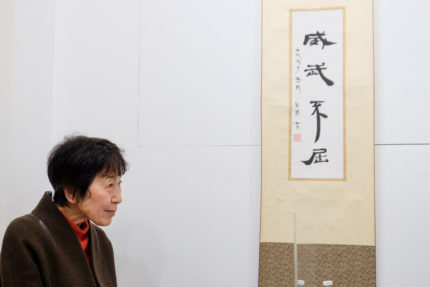
ゲルマー:そうだったんですね。この作品はドイツでも多くの方が足を止めていらっしゃいました。やはり井戸口先生の漢字は、言葉の壁を超えて通じるものがあると思います。ドイツの展覧会にはたくさんの方が来て下さって、特に書道や漢字の作品は人気がありました。井戸口先生は、ドイツについてどんな印象がありますか?
井戸口:初めてドイツへ行った時、普通の住宅でも窓辺にきれいな花が飾ってあるお家が多くて、素敵な国だなと思いました。それと女性のファッションがとても機能的で洗練されているのが良いですね。生活も、ゴミの分別をしっかりされていたり、色々と無駄がなくて、そういうところが好きです。 そういえばゲルマーさんは日本生まれと聞きましたが、どちらの出身ですか?
ゲルマー:私は福岡県小倉の出身で、父親が宮崎出身です。
井戸口:実は私も同じ九州生まれ、宮崎県出身なんですよ。
ゲルマー:それは奇遇ですね。宮崎はいいところがたくさんありますよね。私も先日実家の福岡に帰省して、宮崎もまた行ければと思っていたのですが、コロナのせいで自由に動けなくなってしまいました。井戸口先生もコロナでご苦労されたのではありませんか。
井戸口:緊急事態宣言時は大変でしたが、その後は自分の住んでいる地域は感染者数が少なく、東京などと比べると落ち着いて生活できていたと思います。書道教室の方も、さほど変わりなく続けていられました。とくに年末年始は、子どもたちの書き初めのために忙しく、あまりコロナの恐怖を意識せずに過ごせました。
ゲルマー:生徒さんは小学生ですか?
井戸口:はい、みんな小学生です。中学になると受験勉強などで忙しくなる子も多いので、高学年の子たちは、そろそろ離れていくのかなと思います。
ゲルマー:子どもってみんなそれぞれ個性的ですよね。私もベルリンの音楽学校でフルートを教えていますが、本当にいろんな生徒がいます。10 年以上の付き合いになる子もいて、どう成長していくか楽しみでもありますね。
井戸口:そうですね。高校生になった教え子と路上で話しこんだり、筆で書いていく子もいます。ただ子供を教えるのは年を追うごとに大変になってきたので、今通っている生徒さんたちが全員卒業したら区切りをつけようかと考えています。その後は大人向けの教室も先生と生徒の関係を緩めて、みんなで書を楽しむグループのようにしてもいいですね。
ゲルマー:それが井戸口先生の今後の目標になりますか?
井戸口:目標と言うよりも、こうできたらいいなという思いですね。今もそれに近い状況です。それからもし時間が取れるようになったら、劉洪友先生のところでもう一度しっかりと書を学びたいですね。やはり先生に見てもらえる方が自信が付きますから。
ゲルマー:確かに(師匠がいると)目標も見えやすくなるし、アドバイスも頂けますからね。 井戸口:劉先生の指導には、「威武不屈」のような四字熟語以外にも漢詩を 100 編を書くという課題もありました。書の勉強を本格的に再開できたら、今書いていない書体にも挑戦したいです。ちなみにドイツにも書道のように学生が芸術に取り組む文化はありますか? ゲルマー:音楽学校はありますが、書や詩の大会はありませんね。そもそも普通に暮らしている一般の人々が和歌を詠んだり書道を楽しむという風な文化自体がほとんどないんですよ。それに比べると日本はすごいです。みんなが楽しむことができますから。でもこうした現在の書文化の成長というのは、やはり井戸口先生のように先頭を走る素晴らしい書道家の活躍に促されたものだと思います。ぜひこれからも、素敵な漢字書を書き続けてください。本日はありがとうございました。 (2022年特別対談 井戸口麗煦×ゲルマー・トモコ) To the world, and on to the next generation. A preacher of compassion, passing on the culture of calligraphy Tomoko Germar: Ms. Idoguchi, I’ve seen your works at exhibitions in Ikebukuro (Tokyo) and Germany. I’m honored to be meeting you in person. Reiku Idoguchi: I used to visit a friend who lives in Ulm (a city in Germany) every year, so I feel a great connection with Germany and with you, Ms. Germar. Germar: Oh, really?! Ulm is a lovely city. I also feel that we have a special connection, and of course, your wonderful calligraphy has gained a lot of attention. First of all, can you tell us about your works? Idoguchi: At the start, I studied with a teacher who was good at mixing kanji with kana, so all my exhibition works were poetic pieces. I started by learning modern poetry, and then entered the Institute of Chinese Calligraphy, where I was taught 21 calligraphic styles, starting with the ancient oracle bone script. My teacher had published a collection of calligraphy of four-character Chinese idioms, and this collection inspired me to create Ibufukutsu (Mighty and Unyielding). Previously, I used to create mostly mixed kanji/kana works, but most of my recent works are principally in kanji. Germar: Oh, I see. Many people in Germany stopped to look at this piece. I think that your kanji calligraphy can be perceived on some level beyond the language barrier. Many people visited the exhibition in Germany, and the calligraphy and kanji pieces were especially popular. May I ask, what is your impression of Germany? Idoguchi: When I went to Germany for the first time, I thought it was a wonderful country because there were so many ordinary homes displaying beautiful flowers on the windowsill. I also enjoy how women’s fashion is very functional and sophisticated. I also like the way they live their lives, with their careful separation of trash and the many ways in which they live without waste.By the way, Ms. Germar, I’ve heard that you were born in Japan. Where are you from? Germar: I’m from Kokura, in Fukuoka Prefecture, and my father is from Miyazaki. Idoguchi: Actually, I was born in Kyushu as well, in Miyazaki Prefecture. Germar: Oh, what a coincidence. There are many great things about Miyazaki. I went back to my parents’home in Fukuoka recently and was hoping to visit Miyazaki again, but I wasn’t able to move around freely due to COVID restrictions. Did you also have a hard time due to COVID? Idoguchi: I struggled when the state of emergency was first declared, but after that, the number of infections in my area was low and I was able to live a rather calm life compared to Tokyo and other areas. I was able to continue my calligraphy classes without too much upset. Especially, during the year-end and New Year’s holidays, I was busy with my first calligraphy project for children, so I was able to get by without much awareness or concern for COVID. Germar: Are your students in elementary school? Idoguchi: Yes, they’re all elementary school students. Many of them get busy studying for entrance exams and so on after entering junior high school, so I think the older children are about to leave. Germar: Every child has a unique personality. I also teach the flute at a music school in Berlin, and there are so many different kinds of students. Some of them have been with me for more than 10 years, and I look forward to seeing how they grow. Idoguchi: Yes, that’s right. I bump into previous students of mine, now in high school, and some of them are still practicing calligraphy in my classes. However, teaching children is becoming more and more difficult as the years go by, so I am thinking of taking a break when all of my current students graduate. After that, I hope to relax the teacher-student relationship in the adult classes, making it more like a group where everyone enjoys calligraphy together. Germar: Is that a future goal for you? Idoguchi: Well, not so much a goal, as a wish. I am getting closer to it now. If I had more time, I’d like to study calligraphy again with my teacher, Liu Hongyou. I always feel more confident when I have a teacher watching over me. Germar: It’s true that having an instructor makes it easier to see your own goals and obtain advice. Idoguchi: As well as four-character idioms such as Ibufukutsu, Liu Hongyu also assigned us the task of writing calligraphy for 100 Chinese poems. When I resume my calligraphy studies in earnest, I hope to try my hand at a calligraphic style that I’m not currently pursuing. By the way, does Germany have a culture encouraging students to engage in arts such as calligraphy? Germar: There are music schools, but there are no calligraphy or poetry competitions. Essentially, there is hardly any culture encouraging ordinary people to compose short poems or enjoy calligraphy. In that respect, Japan is amazing. I think the expansion of calligraphy culture has been prompted by the activities of great calligraphic artists such as yourself, who are leading the way in this field. I do hope you continue to pursue the wonderful kanji calligraphy you are known for. Thank you very much for your time today. (Special Talk Session in 2022, Reiku Ideguchi and Tomoko Germer) 知識と鍛錬で培われた美しい書芸術 カトリン=スザンネ・シュミット(以下 シュミット):井戸口先生とは以前直接お会いしたことがありますね。確かニンフェンブルクでしたよね。 井戸口麗煦(以下 井戸口):そうですね。あの時はミュンヘンからウルムまで行くのに一苦労したことをよく覚えています。帰国当日、ミュンヘンからウルムに行こうとする私は空港に向かう人たちと別れ、ホテル近くの駅でバスから降ろされ、荷物と一緒にエレベーターへ。ドアが開いたら、いきなり駅のホーム。改札口は見えない。人影もまばら。不安になっている時、こちらに向かって来られる日本人女性に助けられ、ミュンヘン中央駅まで。ここでお別れして、無事ウルムに着きました(。この方、展覧会を観に来られたそう)。 シュミット:今日は無事にお会いすることができて、本当によかったです。それでは今回ご出展いただいている作品「游于藝」についてお聞きしたいと思います。この作品は 4 年前ミュンヘンにご出展してくれた作品とは雰囲気が違いますね。 井戸口:そうですね。書を続けていれば、日々色々な書体を学び、練習して、取り入れていくものですから。こちらは 10 年ほど前、中国書法学院で学んでいた時、劉先生のお手本をもとに書いたものです。これは東日本大震災の復興祈願の展覧会にも出品した作品で、陸前高田市のコミュニティーホールの外壁にアートタイル壁画として残っています。 シュミット:その名前、懐かしいですね。陸前高田市のコミュニティーホールの建設には、私たち独日協会ベルリンも寄付金を募ってお送りさせていただきました。 井戸口:そうでしたか。本当にシュミットさんとは色々な縁を感じますね。 シュミット:すみません、話を戻しましょう。こちらの作品にはなんと書かれているのですか。 井戸口:「芸を遊ぶ」つまり芸術を楽しむということを意味しています。 シュミット:展覧会にふさわしい、良い言葉ですね。井戸口先生は中国の書を勉強されているそうですが、そのきっかけはどういったものだったんですか。 井戸口:書道自体は小学生の時にやっていたんですが、社会人になってまた書を書きたくなって勉強し直すことにしました。最初は日本人の先生から教わっていたのですが、だんだんと自分の興味が漢字へと傾倒していきまして、それなら中国の書法を学びたいと思うようになったんですね。それで知り合いを通じて中国書法の学校に通い始めたのがきっかけです。それからはそこで出会った劉洪友先生から多くの書体を学ばせて頂きました。 シュミット:良い出会いをされたのですね。井戸口先生の印象は、以前に会った時と同じ、いつも穏やかで優しい。しかし作品から伝わるのは、密度の濃さと気持ちの強さです。一生懸命に学び、研究されたことが見ているとわかります。そしてそれを支えたのが、中国書法学院での出会いだったのですね。ところで先生が書作品を書かれる時、書く前から完成したイメージができていますか? それとも書きながら直感に従って作りますか。 井戸口:どちらの場合もありますね。私はパッと見た時に、なんと書いてあるかわかる字を書きたいので、行書や楷書を少しだけ工夫をした書を書くようにしています。題材になる詩を選んで、簡単に書いてみて、イメージを固めて紙に書くという流れが多いですね。シュミット:なるほど。そこで、これまでの経験や感性というものが活きてくるのですね。書道は『書く道』と表しますよね。だからその一つの作品が出来上がるプロセスにとても興味があるんです。書家の皆さんがどう書く字を決めて、どの紙を選んで、どこに座って、どの筆を選んで、書を書くか。井戸口:なるほど、それで言えばどの墨を選ぶかも非常に重要ですね。書道をする上でいい字を書くために、書くまでの行い、知識や鍛錬がいい字を作ると私自身も感じております。ところでシュミットさん、ドイツにも書道をされる方はいらっしゃるんですか。 シュミット:もちろんいますよ。独日協会にもされている方も多いです。先生は何度もドイツには来られているんですもんね。 井戸口:ウルムに友人がいるので、コロナの感染拡大前には何度も訪ねていました。ドイツ以外にもいろんな国に行きましたが一番興味があるのはドイツですね。 シュミット:嬉しいです。でもそれはなぜですか。 井戸口:最初行った時に美しいな!と思ったんですよ。街並みが綺麗で、どのお家のベランダにも花が咲いていて非常に驚きましたね。 シュミット:そうなんですか!確かにドイツでは景観を守る以外にも自宅のベランダや庭で植物を育てる方が多いですね。私の主人もやっています。ちなみにコロナも落ち着いてきて、これから挑戦してみたいことがありますか。 井戸口:これまで長く漢字の書と向き合ってきたのですが、最近になって改めて最初の頃に書いていたかな混じりの書を懐かしく思うようになりました。ですから当初お世話になっていた先生の作品に習ってもう一度短歌や俳句をかな混じりで書いてみたいですね。 シュミット:初心に返る気持ちを持たれるのは素晴らしいと思います。これからも元気でいいものを作ってください。今日の出会いは忘れません。これからも応援しております。ありがとうございました。 (2022年特別対談 井戸口麗煦×カトリン=スザンネ・シュミット) Beautiful calligraphic art cultivated through knowledge and training. Katrin-Susanne Schmidt: Ms. Idoguchi, we have met in person before, haven’t we? I’m sure we met in Nymphenburg. Reiku Idoguchi: Yes, that’s right. I remember the difficulties I had traveling to Munich. On the day I was due to leave Munich for Ulm on the day I returned home. So I took a bus to the station near my hotel and got into the lift with my luggage. However, when the doors opened, I suddenly arrived at the station platform. I didn’t know where the ticket gate was and there were hardly any other passengers, so I didn’t know what to do.However, a passing Japanese woman took me to Munich Hauptbahnhof station. We parted here and I arrived safely in Ulm. (This lady had come to see the exhibition). Schmidt: Well, I am very glad that we could meet today.I’d like to ask you about the piece you are exhibiting this time,“Yu-u-gei.”This piece has a rather different atmosphere from the work you exhibited in Munich four years ago. Idoguchi: That’s right. I think that if you continue to write calligraphy, you will learn, practise and adopt different calligraphic styles on a daily basis. This is a calligraphy from when I was studying at the Chinese Calligraphy Academy about 10 years ago. I wrote it based on the example of Mr Liu, a teacher at the Academy. It was also exhibited at an exhibition to pray for the recovery from the Great East Japan Earthquake, and remains as an art tile mural on the outside wall of a community hall in Rikuzentakata City. Schmidt: That name brings back memories. At the German-Japanese Society Berlin, we also collected donations for construction of the community hall in Rikuzentakata. Idoguchi: Is that so? Ms. Schmidt, I really feel that we have a lot of connections. Schmidt: Sorry for the distraction. Let’s return to your story. What does this piece say? Idoguchi: In Chinese, it means“to play with art,”or in other words, to enjoy art. Schmidt: That’s a great word for an exhibition.I’ve heard that you have been studying Chinese calligraphy. How did you start doing that? Idoguchi: I’d studied calligraphy in elementary school, but after becoming an adult, I wanted to do it again, so I decided to study it. At first, I was taught by a Japanese teacher, but my interest gradually shifted toward Chinese characters, and I decided that I wanted to learn Chinese calligraphy. Through an acquaintance, I began attending a Chinese calligraphy school. After that, I learned many calligraphic styles from Liu Hongyou, whom I met there. Schmidt: It sounds like that was a great encounter. My impression of you, Ms. Idoguchi, is the same as when I met you before, always calm and easygoing. However, your works convey a certain solidity and strength of emotion. I can tell by looking at your work that you have devoted great effort to study and research. And your encounters at the Chinese Calligraphy Association supported you in this. By the way, when you create a piece of calligraphy, do you have an image of the finished work in mind before you write anything? Or do you follow your intuition as you create? Idoguchi: Actually, I do both. I want to write characters that are recognizable at a single glance, so I try to write calligraphy with a slight twist on standard gyosho or kaisho scripts. I often choose a poem as a subject, try to write it out simply, and then put it on paper after I have a clear image of what I want to create. Schmidt: Oh, that’s interesting. So this is where your experience and sensitivity come into play. After all, calligraphy is the“way of writing,”isn’t it? That’s why I am so interested in the process of creating a calligraphy piece. How does the calligrapher decide which characters to write, which paper to use, where to sit, which brush to use? Idoguchi: I see. The choice of ink is very important too. I myself feel that the actions, knowledge, and training undertaken before the writing process are what make for great calligraphy. By the way, Ms. Schmidt, do many people practice calligraphy in Germany? Schmidt: Yes, naturally. Many people in the German-Japanese Society practice it. You have visited Germany many times, haven’t you? Idoguchi: I have a friend in Ulm, so I visited there many times before the outbreak of COVID-19. I ’ve traveled to many countries besides Germany, but I am most interested in Germany. Schmidt: It’s nice to hear that. But why is that? Idoguchi: Well, when I first went there, I thought it was beautiful! The streets were beautiful, and I was very surprised to see flowers on the balcony of every house. Schmidt: Really? It’s true that in addition to conserving the natural landscape, many people in Germany grow plants on their balconies and in their gardens. My husband does the same. By the way, now that the COVID situation has settled down a bit, is there anything you would like to try in the future? Idoguchi: I have been working with kanji calligraphy for a long time, but recently, I have started to miss the mixed kana script calligraphy that I used to create in my early days. So I would like to try writing tanka and haiku poems again using mixed kana script, following in the footsteps of the teachers who helped me in the beginning. Schmidt: I think it’s wonderful that you have this desire to return to the beginning. I hope you stay healthy and continue to create works. Today’s encounter was very memorable. I look forward to seeing what you do next. Thank you very much. (Special Talk Session in 2022, Reiku Ideguchi and Katrin-Susanne Schmidt:) 特設個展ブースin 日欧宮殿芸術祭2024 Solo Exhibition in JEPAA Festival 2024 1946年 宮崎県出身 Born: 1946 , Japan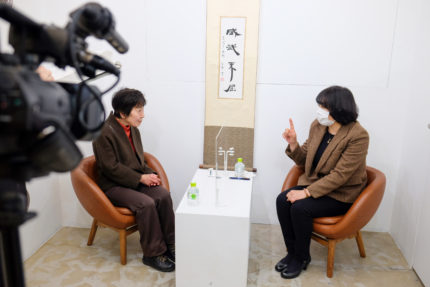
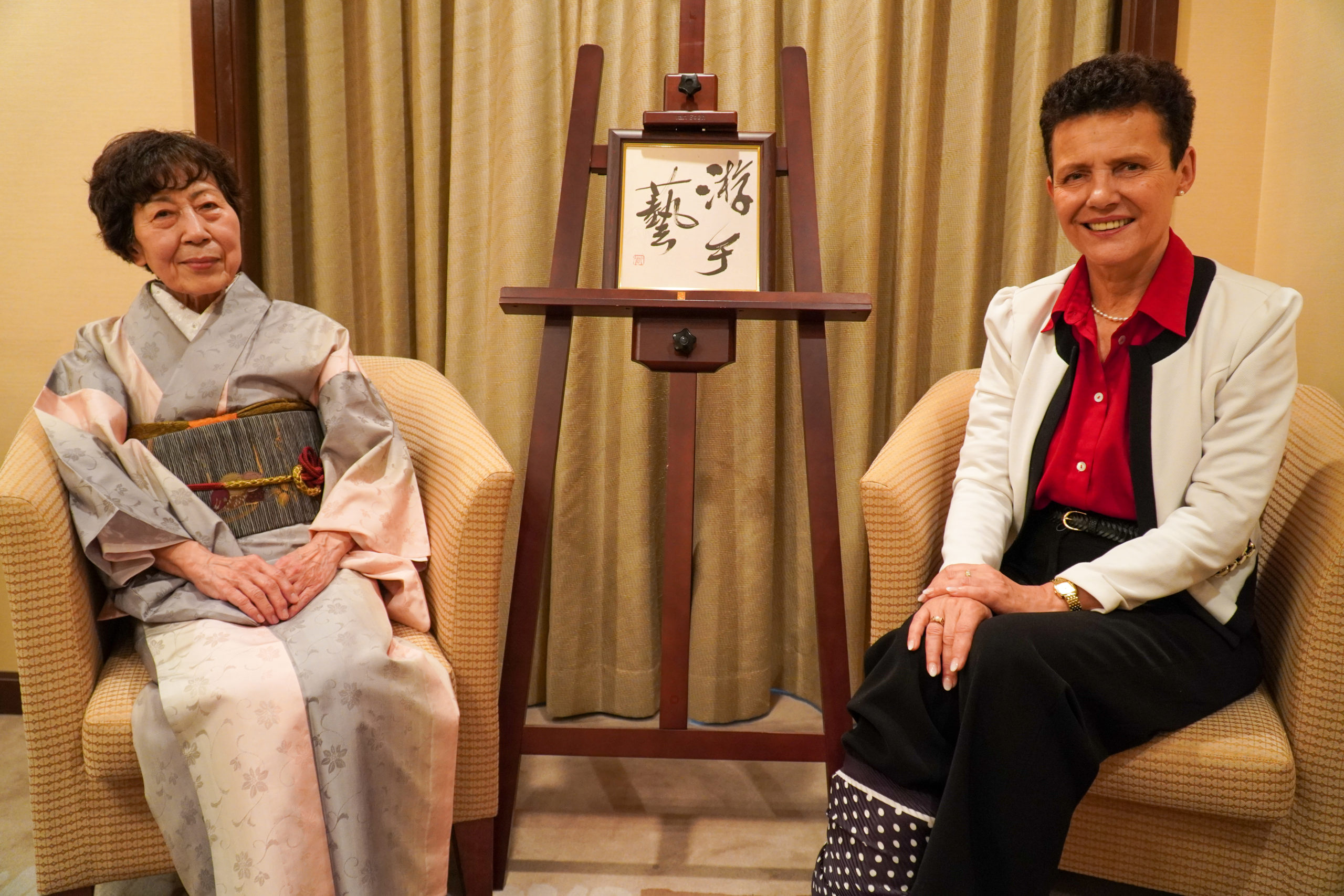
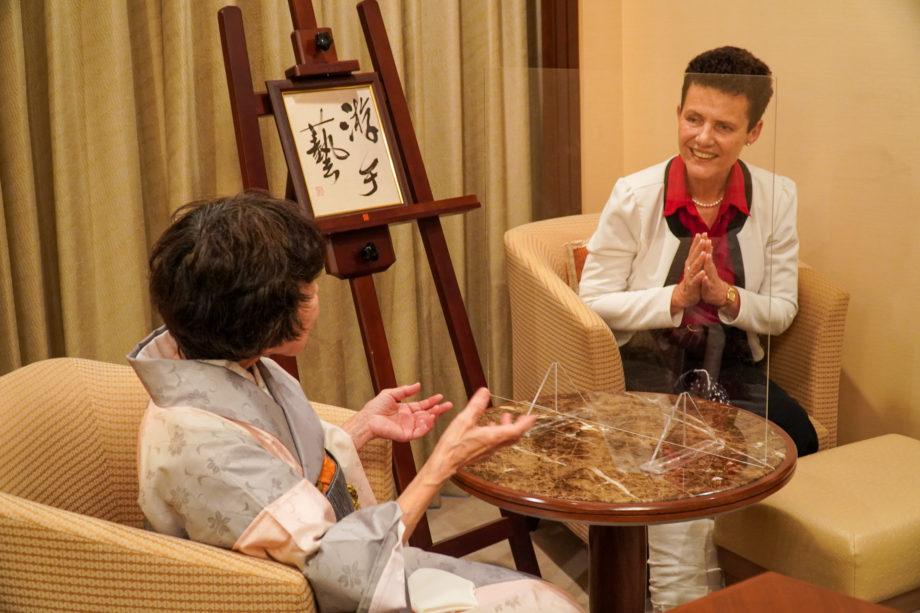
Solo Exhibition /個展
会期:2024年4月20日~22日
会場:シャルロッテンブルク宮殿オランジュリー(ドイツ)
主催:一般社団法人 日欧宮殿芸術協会
運営:クリエイト・アイエムエス株式会社
Date: April 20th – 22th, 2024
Venue: Charlottenburg Palace, Berlin, Germany
Organizer: Japan-Europe Palace Art Association
Operated by: Create IMS Co., Ltd.
展覧会 /Exhibition
Profile /経歴
師:劉洪友
作品出展国遍歴(JEPAA関連事業):ドイツ、オーストリア、ベルギー他
Master: Ryū Kōyū
Exhibition of Works(JEPAA): Germany, Austria, Belgium,…




